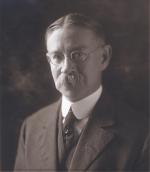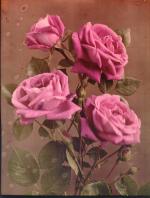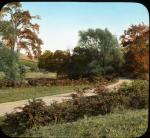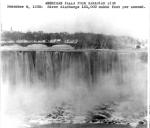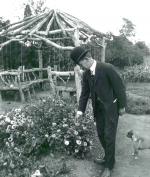![header=[Marker Text] body=[Printer, horticulturist, conservationist, and "City Beautiful" advocate. President, American Civic Association, 1904-24, and editor, "American Rose Annual," 1916-43. He worked successfully for preservation of Niagara Falls and creation of the National Park Service. McFarland stressed the duty of civic leaders to build a beautiful, healthful environment. His Breeze Hill home and gardens were in Harrisburg's Bellevue Park. ] sign](http://explorepahistory.com/kora/files/1/10/1-A-3C9-139-ExplorePAHistory-a0m8e4-a_450.jpg)
Mouse over for marker text
Name:
J. Horace McFarland
Region:
Hershey/Gettysburg/Dutch Country Region
County:
Dauphin
Marker Location:
Garden in Riverfront Park, Front and Verbeke Sts., Harrisburg
Dedication Date:
June 6, 1994
Behind the Marker
One of the natural wonders of the world, Niagara Falls for more than a century has also been a fabled honeymoon destination. In the early 1900s, however, the Falls nearly became a casualty of the industrial revolution.
We owe the Falls' preservation in large measure to J. Horace McFarland (1859-1948) of Harrisburg, Pennsylvania, founder and long-time head of the American Civic Association. McFarland led the national campaign that saved the land immediately around Niagara Falls from the power plants that still abound in the region, the largest of which was built by Westinghouse Electric Company in 1896. After leading an urban renewal campaign that made Harrisburg a national model, McFarland was also a founder of the National Park system, and promoter of the rose to its position as America's favorite flower.
McFarland began his working life setting type for his father, who published a reform newspaper called The Temperance Vindicator, and working on the family nursery along the banks of the Susquehanna River. After the paper went out of business in 1878, McFarland, then nineteen, began to print seed catalogs with pictures of fruits, flowers, and vegetables. Soon, he started the Mount Pleasant Press, which earned a reputation for its attractive graphics.
By 1898, McFarland was experimenting with color photography, the use of which helped make his catalogues famous throughout the nation. His quality work led Macmillan and Doubleday to outsource their books on horticulture to his press for over thirty years. He also taught at the Harvard Business School, where in 1912 he instituted the program in printing. McFarland also achieved note as a writer. His articles for Outlook magazine in the 1890s were collected and published as Getting Acquainted with the Trees in 1904, which the New York Public Library lauded as one of the year's finest books.
McFarland's interest in plants and nature also led him into the urban reform and the environmental movements. Although it was the Commonwealth's capital, in the late 1800s Harrisburg was a run down and gritty industrial town, with its water polluted by raw sewage, garbage, and trash strewn on its river bank and lots, and few public amenities. After 1900, with colleague Mira Lloyd Dock, McFarland led the effort to clean up and modernize the city of Harrisburg. Together they promoted the construction of Riverfront Park, which runs the length of the city of Harrisburg on the Susquehanna River, a water filtration plant, street paving and the creation of playgrounds and gardens.
Mira Lloyd Dock, McFarland led the effort to clean up and modernize the city of Harrisburg. Together they promoted the construction of Riverfront Park, which runs the length of the city of Harrisburg on the Susquehanna River, a water filtration plant, street paving and the creation of playgrounds and gardens.
After successfully leading the struggle to reclaim Harrisburg's waterfront, McFarland helped found and became the first President of the American Civic Association, a post he held from 1904 until 1924. Through the Association he took the "Harrisburg Plan" all over America with his lectures and slide shows. More than 400 communities responded to his call to establish parks and gardens not only as beautiful objects in themselves, but as places that would raise the human spirit and lead to moral improvement.
"Harrisburg Plan" all over America with his lectures and slide shows. More than 400 communities responded to his call to establish parks and gardens not only as beautiful objects in themselves, but as places that would raise the human spirit and lead to moral improvement.
Through the American Civic Association, McFarland also became involved in the movement to preserve the nation's natural wonders. In 1905, McFarland mounted a campaign for the protection of Niagara Falls from power companies that resulted in an international treaty with Canada limiting water diversions and protecting its scenic values.
At the first national Conference on Conservation, which President Theodore Roosevelt convened in 1908 to determine the fate of the nation's rapidly disappearing forests, McFarland, John Muir, and other pioneers in the American natural preservation movement argued unsuccessfully that certain resources should be preserved untouched because of their natural beauty, and the emotional and spiritual impact they would upon those who visited them.
After the preservationists' failure in 1913 to prevent the damming of California's beautiful Hetch Hetchy River and Valley, McFarland lobbied effectively for the creation of a national park system to better protect and manage the nation's forty-one national parks and monuments. Working with successive secretaries of the interior and elected officials, McFarland witnessed creation of the National Park Service in 1916.
In the decades that followed, McFarland served on the Department of the Interior's Educational Advisory Board and as a member of the National Park Trust Board, and continued to campaign for the protection of existing preserves and creation of new ones, including the Shenandoah, Everglades, and Grand Teton national parks.
He also devoted the last three decades of his long life to roses. McFarland edited the American Rose Annual from 1916 to 1948, planted one of the nation's leading rose gardens at his home on Breeze Hill in Harrisburg, and wrote several books on roses and many articles on gardening for leading national magazines. Through these efforts he was instrumental in making the rose America's most popular flower.
One of the natural wonders of the world, Niagara Falls for more than a century has also been a fabled honeymoon destination. In the early 1900s, however, the Falls nearly became a casualty of the industrial revolution.
We owe the Falls' preservation in large measure to J. Horace McFarland (1859-1948) of Harrisburg, Pennsylvania, founder and long-time head of the American Civic Association. McFarland led the national campaign that saved the land immediately around Niagara Falls from the power plants that still abound in the region, the largest of which was built by Westinghouse Electric Company in 1896. After leading an urban renewal campaign that made Harrisburg a national model, McFarland was also a founder of the National Park system, and promoter of the rose to its position as America's favorite flower.
McFarland began his working life setting type for his father, who published a reform newspaper called The Temperance Vindicator, and working on the family nursery along the banks of the Susquehanna River. After the paper went out of business in 1878, McFarland, then nineteen, began to print seed catalogs with pictures of fruits, flowers, and vegetables. Soon, he started the Mount Pleasant Press, which earned a reputation for its attractive graphics.
By 1898, McFarland was experimenting with color photography, the use of which helped make his catalogues famous throughout the nation. His quality work led Macmillan and Doubleday to outsource their books on horticulture to his press for over thirty years. He also taught at the Harvard Business School, where in 1912 he instituted the program in printing. McFarland also achieved note as a writer. His articles for Outlook magazine in the 1890s were collected and published as Getting Acquainted with the Trees in 1904, which the New York Public Library lauded as one of the year's finest books.
McFarland's interest in plants and nature also led him into the urban reform and the environmental movements. Although it was the Commonwealth's capital, in the late 1800s Harrisburg was a run down and gritty industrial town, with its water polluted by raw sewage, garbage, and trash strewn on its river bank and lots, and few public amenities. After 1900, with colleague
After successfully leading the struggle to reclaim Harrisburg's waterfront, McFarland helped found and became the first President of the American Civic Association, a post he held from 1904 until 1924. Through the Association he took the
Through the American Civic Association, McFarland also became involved in the movement to preserve the nation's natural wonders. In 1905, McFarland mounted a campaign for the protection of Niagara Falls from power companies that resulted in an international treaty with Canada limiting water diversions and protecting its scenic values.
At the first national Conference on Conservation, which President Theodore Roosevelt convened in 1908 to determine the fate of the nation's rapidly disappearing forests, McFarland, John Muir, and other pioneers in the American natural preservation movement argued unsuccessfully that certain resources should be preserved untouched because of their natural beauty, and the emotional and spiritual impact they would upon those who visited them.
After the preservationists' failure in 1913 to prevent the damming of California's beautiful Hetch Hetchy River and Valley, McFarland lobbied effectively for the creation of a national park system to better protect and manage the nation's forty-one national parks and monuments. Working with successive secretaries of the interior and elected officials, McFarland witnessed creation of the National Park Service in 1916.
In the decades that followed, McFarland served on the Department of the Interior's Educational Advisory Board and as a member of the National Park Trust Board, and continued to campaign for the protection of existing preserves and creation of new ones, including the Shenandoah, Everglades, and Grand Teton national parks.
He also devoted the last three decades of his long life to roses. McFarland edited the American Rose Annual from 1916 to 1948, planted one of the nation's leading rose gardens at his home on Breeze Hill in Harrisburg, and wrote several books on roses and many articles on gardening for leading national magazines. Through these efforts he was instrumental in making the rose America's most popular flower.




